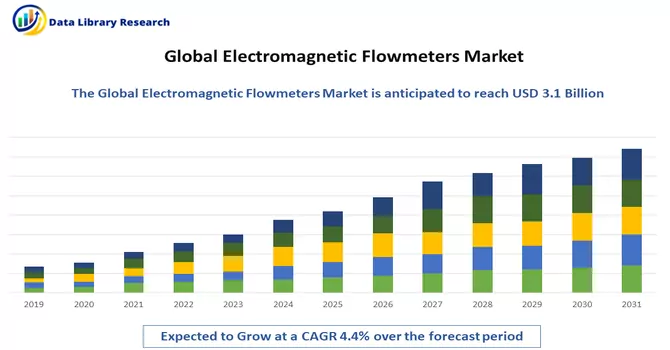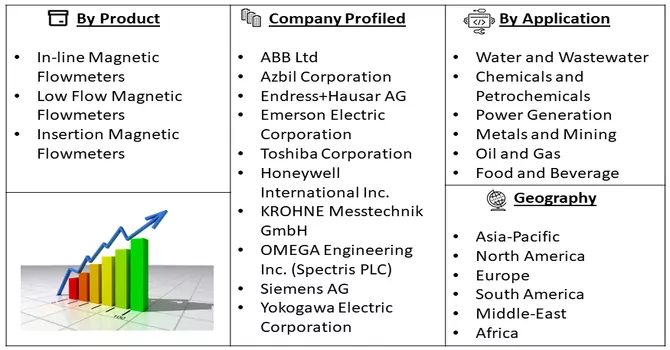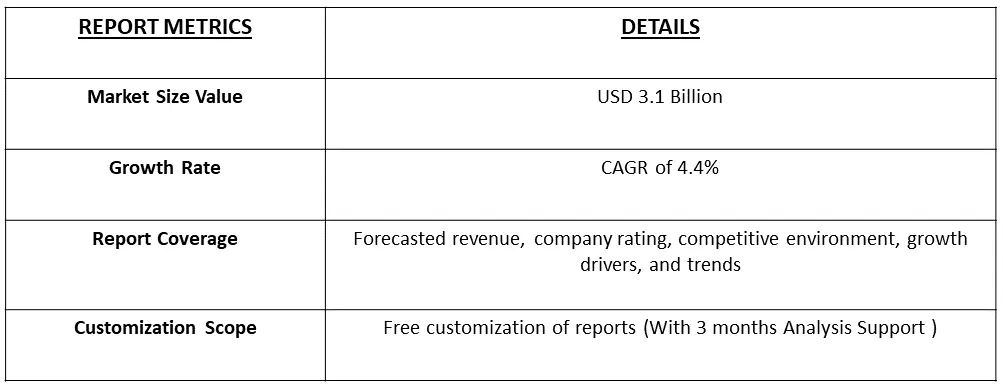The Global Magnetic Flowmeter Market is poised to reach USD 3.1 Billion in the year 2023 and is expected to register a CAGR of 4.4% during the forecast period 2024-2031.

Get Complete Analysis Of The Report - Download Free Sample PDF
The Global Electromagnetic Flowmeter is a widely utilized instrument designed to measure the flow rate of electrically conductive fluids like water or various industrial liquids. Operating on electromagnetic induction principles, this flowmeter generates a magnetic field through coils, inducing a voltage proportional to the fluid velocity as it passes through the pipe. Renowned for high accuracy, reliability, and versatility, electromagnetic flowmeters find applications in water management, chemical processing, food, pharmaceuticals, and more.
They offer a non-intrusive method for precise flow measurement globally. The market growth is propelled by the increasing demand for accurate and reliable industrial fluid measurements. In mining, challenging conditions like abrasive slurries and corrosive fluids make electromagnetic flowmeters preferable. Their maintenance efficiency, compatibility with conductive liquids, and suitability for various line sizes make them advantageous. Industries prioritizing high accuracy, with investments focusing on the 0.2% to 0.5% accuracy range, further drive the adoption of electromagnetic flowmeters for precise flow monitoring.
The Global Electromagnetic Flowmeter market is witnessing significant trends that are shaping its trajectory and driving its growth. One prominent trend is the increasing demand for precise flow measurement across various industries, such as water and wastewater management, chemical processing, and pharmaceuticals. The emphasis on accuracy and reliability in fluid measurement is fueling the adoption of Electromagnetic Flowmeters, known for their high precision and versatility. In response to the challenges posed by abrasive conditions in industries like mining, the market is experiencing a trend of heightened adoption of Electromagnetic Flowmeters due to their resilience in measuring abrasive slurries and corrosive fluids. The technology's compatibility with conductive liquids and its ability to handle challenging conditions contribute to its growing popularity. The industries are investing in flowmeters with accuracy levels ranging from 0.2% to 0.5%, demonstrating a trend towards prioritizing precision in flow measurement applications. The maintenance efficiency of Electromagnetic Flowmeters, coupled with their adaptability to various line sizes without pressure loss, further contributes to their widespread adoption. Overall, the market trends indicate a growing recognition of Electromagnetic Flowmeters as indispensable instruments for accurate and reliable fluid measurement across diverse industrial sectors, reflecting an increased focus on efficiency, precision, and adaptability in fluid-handling processes worldwide.
Market Segmentation: Global Electromagnetic Flowmeter Market is segmented by Product (In-line Magnetic Flowmeters, Low Flow Magnetic Flowmeters, Insertion Magnetic Flowmeters), by Application (Water and Wastewater, Chemicals and Petrochemicals, Power Generation, Metals and Mining, Oil and Gas, Food and Beverage), and Geography (North America, Europe, Asia Pacific, Latin America, MEA). The market sizes and forecasts are provided in terms of value (USD million) for all the above segments.

For Detailed Market Segmentation - Download Free Sample PDF
Market Drivers:
Water Shortage and the Growing Population
The pressing global issues of water shortage and a burgeoning population are key drivers propelling the growth of the Electromagnetic Flowmeter Market. As the demand for water escalates with a growing population, effective water management becomes paramount. Electromagnetic flowmeters play a crucial role in optimizing water distribution, ensuring efficient usage, and minimizing wastage. With their ability to provide accurate and reliable measurements in diverse fluid-handling processes, electromagnetic flowmeters are increasingly adopted in water and wastewater management systems. The technology aids in enhancing the precision of flow measurements, promoting sustainable water practices, and addressing the challenges posed by water scarcity. In regions grappling with water shortages and escalating demand, the deployment of electromagnetic flowmeters becomes instrumental in achieving effective water resource management, making them integral components in the global efforts to tackle the intersections of population growth and water scarcity.
Technological Innovations in Irrigation
Technological innovations in irrigation practices are driving significant advancements in the Electromagnetic Flowmeter Market. As agriculture embraces modernization, the integration of electromagnetic flowmeters in irrigation systems emerges as a key solution for optimizing water usage and enhancing precision in flow measurements. These innovations enable farmers to achieve more efficient irrigation strategies by providing accurate real-time data on water flow rates. Electromagnetic flowmeters contribute to sustainable agriculture practices, ensuring that water resources are utilized effectively while minimizing wastage. The technology's compatibility with digital systems and the ability to remotely monitor and control irrigation processes align with the broader trend of smart agriculture. As the agricultural sector increasingly adopts these innovations to address water scarcity challenges and promote efficient resource management, the Electromagnetic Flowmeter Market continues to expand its footprint in irrigation applications, offering a crucial tool for advancing precision agriculture and sustainable water use practices worldwide.
Market Restraints:
The Inability to Measure Non-conductive Fluids
The inability to measure non-conductive fluids represents a potential impediment to the growth of the Electromagnetic Flowmeter Market. While electromagnetic flowmeters excel in measuring electrically conductive fluids due to the induction principles they operate on, they face limitations in applications involving non-conductive fluids. Non-conductive fluids lack the necessary ions to generate the induced voltage essential for accurate flow measurements in electromagnetic flowmeters. This limitation hinders their suitability for industries or processes where non-conductive fluids are prevalent, such as certain chemical applications or the handling of specific solvents. Efforts to overcome this limitation may involve the exploration of alternative technologies or the combination of electromagnetic flowmeters with other measurement methods. Innovations addressing the measurement challenges posed by non-conductive fluids could unlock new opportunities for electromagnetic flowmeters, expanding their applicability across a broader spectrum of industries. Until then, the inability to effectively measure non-conductive fluids may slow the market's growth, prompting industry players to explore solutions that enhance the versatility of electromagnetic flowmeters and address the evolving needs of diverse fluid-handling processes.
The COVID-19 pandemic has left a distinct imprint on the Electromagnetic Flowmeter Market. While certain sectors experienced setbacks due to economic slowdowns and disruptions in supply chains, others, particularly in healthcare and pharmaceuticals, witnessed an increased demand for precise flow measurements. The reliability of electromagnetic flowmeters became pivotal in critical applications such as medical devices and pharmaceutical manufacturing. Conversely, industries like oil and gas initially faced challenges with project delays, but a gradual recovery and increased investments are expected to drive renewed demand for electromagnetic flowmeters. The pandemic also accelerated the adoption of digital solutions, aligning with Industry 4.0 trends, and electromagnetic flowmeters, with their compatibility, have become essential components in enhancing efficiency and enabling remote monitoring capabilities, shaping the market's post-pandemic landscape.
Segmental Analysis:
Low Flow Magnetic Flowmeters Segment is Expected to Witness Significant Growth Over the Forecast Period
Low flow magnetic flowmeters represent a specialized category within the broader electromagnetic flowmeter market, designed to accurately measure and monitor low flow rates of electrically conductive fluids. These flowmeters operate on the principle of Faraday's law of electromagnetic induction, where a magnetic field is created, and the induced voltage is proportional to the fluid velocity. In low flow applications, maintaining precision is crucial, and these magnetic flowmeters excel in providing accurate measurements in situations where flows are at minimal rates. One of the primary advantages of low flow magnetic flowmeters is their sensitivity to low flow rates, making them ideal for applications where precise fluid measurement is critical. Industries such as pharmaceuticals, laboratories, and certain chemical processes require the ability to measure and control low-flow rates with precision, and low-flow magnetic flowmeters fulfil this need efficiently. These specialized flowmeters often feature compact designs, minimizing the internal volume of the metering tube to enhance sensitivity to low flows. They find utility in applications such as dosing, batching, and monitoring processes where maintaining accuracy in low-flow conditions is paramount. With their advanced capabilities, low-flow magnetic flowmeters contribute significantly to industries demanding meticulous fluid control and measurement in situations with minimal flow rates, ensuring optimal efficiency and reliability in various industrial processes.
Chemicals and Petrochemicals Segment is Expected to Witness Significant Growth Over the Forecast Period
The Chemicals and Petrochemicals industry plays a pivotal role in driving the demand for electromagnetic flowmeters, offering precise and reliable flow measurement solutions for various processes. Electromagnetic flowmeters find extensive application in this sector, facilitating accurate measurement of liquid flow rates, which is crucial for optimizing production processes, ensuring product quality, and maintaining operational efficiency. In chemical manufacturing, where precision is paramount, electromagnetic flowmeters excel in providing accurate measurements of corrosive and abrasive fluids, ensuring the integrity of chemical compositions. These flowmeters are resistant to corrosion and wear, making them well-suited for the challenging environments inherent in the chemicals and petrochemicals sector. The Petrochemical industry, encompassing the production of hydrocarbons and their derivatives, relies on electromagnetic flowmeters for monitoring and controlling the flow of various liquids, including crude oil and refined petroleum products. The ability of electromagnetic flowmeters to handle diverse fluid properties, resist harsh chemicals, and operate in demanding conditions makes them instrumental in optimizing petrochemical processes. Moreover, the seamless integration of electromagnetic flowmeters with digital and automation systems aligns with the industry's move towards Industry 4.0, enhancing efficiency, reducing operational costs, and ensuring compliance with stringent regulations. Thus, the Chemicals and Petrochemicals industry's reliance on precise fluid measurements for optimal production and quality control positions electromagnetic flowmeters as indispensable tools, contributing significantly to the efficiency and reliability of processes within this vital sector.
North America Region Segment is Expected to Witness Significant Growth Over the Forecast Period
North America plays a significant role in shaping the Global Electromagnetic Flowmeter Market, contributing to its growth and technological advancements. The region's robust industrial infrastructure, coupled with a focus on innovation, drives the adoption of electromagnetic flowmeters across diverse applications. In North America, industries such as water and wastewater management, chemical processing, and oil and gas leverage electromagnetic flowmeters for precise and reliable fluid measurement. The strict regulatory environment regarding environmental compliance in the region further emphasizes the need for accurate flow measurement solutions, reinforcing the market for electromagnetic flowmeters. The demand for advanced technologies and the integration of Industry 4.0 principles in manufacturing processes have led North American industries to embrace electromagnetic flowmeters, contributing to increased efficiency and automation. The region's commitment to sustainability and resource management also fuels the adoption of electromagnetic flowmeters in water-related applications. On a global scale, North America stands as a key player in the electromagnetic flowmeter market, influencing market trends and technological innovations. The region's continual investments in research and development, along with strategic partnerships, contribute to the evolution of electromagnetic flowmeter technologies. In conclusion, North America's active participation in the Global Electromagnetic Flowmeter Market reflects its pivotal role in driving advancements, fostering innovation, and contributing to the overall growth and development of this critical segment within the fluid measurement industry.

Get Complete Analysis Of The Report - Download Free Sample PDF
The competition in the Global Electromagnetic Flowmeter Market is intense, with companies actively expanding their market share through strategic partnerships and continual investments in the development and introduction of new products. In order to gain a competitive edge throughout the forecast period, companies are engaging in collaborative initiatives and leveraging innovative product offerings. These partnerships not only enhance market presence but also foster technological advancements, ensuring that businesses stay at the forefront of the rapidly evolving electromagnetic flowmeter landscape. By focusing on such strategic endeavors, companies aim to solidify their positions in the market, meet the evolving demands of consumers, and navigate the competitive terrain effectively. This approach underscores the dynamic nature of the industry, where staying competitive involves a proactive and collaborative stance, driving innovation and ensuring a robust market presence for sustained growth. The key market players working in this domain are:
Recent Developments:
1) In July 2022, Siemens Greece joined forces with the municipal water and sewerage company of Larissa (DEYAL), showcasing Siemens' participation at the prestigious IFAT, the premier trade fair for water, sewage, waste, and raw material management globally. Siemens is actively contributing to this flagship project by offering advanced water and sewage facility/network management solutions, along with innovative rural area irrigation solutions. Notably, Siemens' implementation of high energy efficiency pumps, cutting-edge flowmeters, and Industry 4.0 solutions has already resulted in substantial energy savings and reductions in seepage loss.
2) In November 2021, ABB demonstrated its expertise in electromagnetic flowmeters, covering the entire water cycle, from extraction and treatment to metering and distribution. ABB boasts an extensive range of electromagnetic flow meters and measurement products designed for application across all stages of the water cycle. In a strategic collaboration, ABB partnered with the Danish water environment DHI Group to develop a suite of digital solutions aimed at facilitating faster and more accurate decision-making for water and wastewater utilities, showcasing their commitment to advancing technological solutions in the water management sector.
Q1. What was the Electromagnetic Flowmeters Market size in 2023?
As per Data Library Research the Global Magnetic Flowmeter Market is poised to reach USD 3.1 Billion in the year 2023.
Q2. At what CAGR is the Magnetic Flowmeter Market projected to grow within the forecast period?
Magnetic Flowmeter Market is expected to register a CAGR of 4.4% during the forecast period.
Q3. What are the factors driving the Magnetic Flowmeter Market?
Key factors that are driving the growth include the Water Shortage and the Growing Population and Technological Innovations in Irrigation.
Q4. Which Region is expected to hold the highest Market share?
North America region is expected to hold the highest Market share.
Data Library Research are conducted by industry experts who offer insight on industry structure, market segmentations technology assessment and competitive landscape (CL), and penetration, as well as on emerging trends. Their analysis is based on primary interviews (~ 80%) and secondary research (~ 20%) as well as years of professional expertise in their respective industries. Adding to this, by analysing historical trends and current market positions, our analysts predict where the market will be headed for the next five years. Furthermore, the varying trends of segment & categories geographically presented are also studied and the estimated based on the primary & secondary research.
In this particular report from the supply side Data Library Research has conducted primary surveys (interviews) with the key level executives (VP, CEO’s, Marketing Director, Business Development Manager and SOFT) of the companies that active & prominent as well as the midsized organization
FIGURE 1: DLR RESEARH PROCESS

Extensive primary research was conducted to gain a deeper insight of the market and industry performance. The analysis is based on both primary and secondary research as well as years of professional expertise in the respective industries.
In addition to analysing current and historical trends, our analysts predict where the market is headed over the next five years.
It varies by segment for these categories geographically presented in the list of market tables. Speaking about this particular report we have conducted primary surveys (interviews) with the key level executives (VP, CEO’s, Marketing Director, Business Development Manager and many more) of the major players active in the market.
Secondary ResearchSecondary research was mainly used to collect and identify information useful for the extensive, technical, market-oriented, and Friend’s study of the Global Extra Neutral Alcohol. It was also used to obtain key information about major players, market classification and segmentation according to the industry trends, geographical markets, and developments related to the market and technology perspectives. For this study, analysts have gathered information from various credible sources, such as annual reports, sec filings, journals, white papers, SOFT presentations, and company web sites.
Market Size EstimationBoth, top-down and bottom-up approaches were used to estimate and validate the size of the Global market and to estimate the size of various other dependent submarkets in the overall Extra Neutral Alcohol. The key players in the market were identified through secondary research and their market contributions in the respective geographies were determined through primary and secondary research.
Forecast Model
